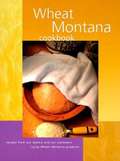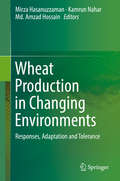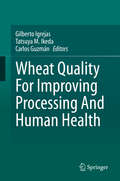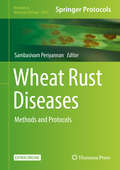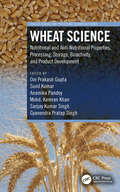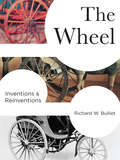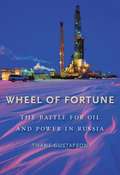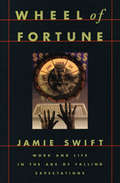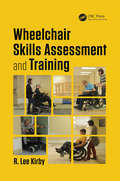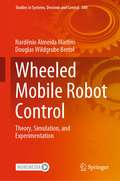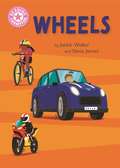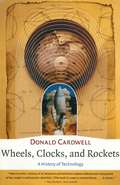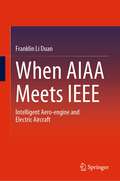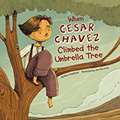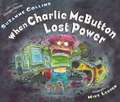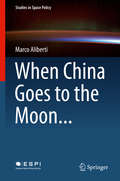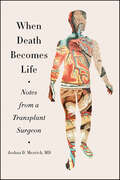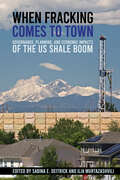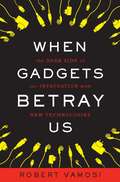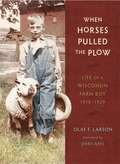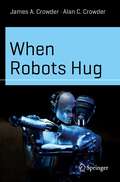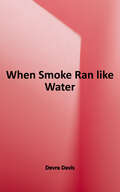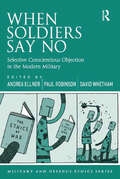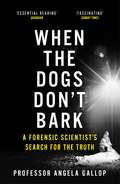- Table View
- List View
Wheat Montana Cookbook: Recipes From Our Bakery and Our Customers Using Wheat Montana Products
by Wheat MontanaFrom the book's back cover: You've enjoyed their famous wheat products for years. Now the folks at Wheat Montana share some of their favorite recipes from the Wheat Montana Bakery and Deli in Three Forks, Montana, their home kitchens, and their loyal customers. Learn how to make pillowy loaves of bread, cinnamon-sweetened rolls, robust chili, flavor-packed muffins and cakes, and much more using the hearty, healthy wheat and wheat products grown and developed on Wheat Montana Farms. This book presents the endless epicurean possibilities of wheat- the staff of life. Wheat Montana's Natural White® flour, Bronze Chief and Prairie Gold whole wheat flours, wheat berries, and 7-grain mix all flavor the recipes collected here-from soups to salads, biscotti to biscuits. [You won't want to miss Adah Horne's Quick Oatmeal Bread or Heidi Lutgen's Strudel. Yumm!]
Wheat Production in Changing Environments: Responses, Adaptation and Tolerance
by Mirza Hasanuzzaman Kamrun Nahar Md. Amzad HossainThis book presents recent advances in global wheat crop research, including the effects of abiotic stresses like high and low temperatures, drought, hypoxia, salinity, heavy metals, nutrient deficiency, and toxicity on wheat production. It also highlights various approaches to alleviate the damaging effects of abiotic stress on wheat as well as advanced approaches to develop abiotic-stress-tolerant wheat crops. Wheat is probably one of the world’s most important cereals; it is a staple food in more than 40 countries, and because of its adaptability is cultivated in almost every region. Global wheat production has more than doubled in the last 50 years due to higher yields. However, despite their high yield potential, modern wheat cultivars are often subject to crop loss due to the abiotic stresses. As such, plant breeders have long aimed to improve tolerance in order to maintain yield. Written by 85 experts, and offering the latest insights into wheat responses and tolerance to various abiotic stresses, it is a valuable tool for agronomists, plant breeders, plant physiologists and students in the field of plant science and agriculture. It is the first book to comprehensively cover past and current abiotic stress problems and tolerance mechanisms.
Wheat Quality For Improving Processing And Human Health
by Gilberto Igrejas Tatsuya M. Ikeda Carlos GuzmánWheat Quality for Improving Processing and Human Health brings together an international group of leading wheat scientists to outline highly relevant and diverse aspects and the latest advances in understanding of the world’s most consumed cereal. Topics covered include LMW glutenins, starch-related proteins, and the impact of processing on composition and consumer health. Individual chapters focus on important factors such as FODMAPs, protein structure, dough viscoelasticity and fumonisins. The environmental effects on allergen content are comprehensively covered, as are phenolic compounds and molecular markers. The major quality screening tools and genetic resources are reviewed in depth. Gluten is a major focus of this work with chapters dedicated to health effects, analytical methods and standards, proteomics and mutant proteins. Starting in 2015, wheat quality scientists from across the globe have united to develop the Expert Working Group for Improving Wheat Quality for Processing and Health under the umbrella of the Wheat Initiative. This joint effort provides a framework to establish strategic research and organisation priorities for wheat research at the international level in both developed and developing countries. This Expert Working Group aims to maintain and improve wheat quality for processing and health under varying environmental conditions. The Group focuses on a broad range of wheat quality issues including seed proteins, carbohydrates, nutrition quality and micronutrient content, grain processing and food safety. Bioactive compounds are also considered, both those with negative effects such as allergens and mycotoxins, and those with positive effects such as antioxidants and fibre. The Group also works in the development of germplasm sets and other tools that promote wheat quality research. Wheat quality specialists working on the wheat value chain, and nutritionists will find this book a useful resource to increase and update their knowledge of wheat quality, nutrition and health issues.
Wheat Rust Diseases
by Sambasivam PeriyannanThis volume presents a collection of tools currently used for the characterization of rust, the host plant wheat, and their interactions. This book is divided into five parts: Parts I and II discuss advanced techniques for characterizing rust pathogens in rust surveillance, genotyping, and molecular pathogenicity; Part III describes protocols for genetic analysis of rust resistance; Part IV covers methods on rust resistance gene cloning; and Part V talks about the isolation and screening of bacterial endophytes as biocontrol agents for rust disease management. Written in the highly successful Methods in Molecular Biology series format, chapters include introductions to their respective topics, lists of the necessary materials and reagents, step-by-step, readily reproducible laboratory protocols, and tips on troubleshooting and avoiding known pitfalls. Cutting-edge and authoritative, Wheat Rust Disease: Methods and Protocols is a valuable resource for both established and novel wheat rust researchers and also the plant science and microbial research community.
Wheat Science: Nutritional and Anti-Nutritional Properties, Processing, Storage, Bioactivity, and Product Development (Cereals)
by Om Prakash Gupta Sunil Kumar Anamika Pandey Mohd. Kamran Khan Sanjay Kumar Singh Gyanendra Pratap SinghGlobally, significant work has been done to enhance our current understanding of the nutritional and anti-nutritional properties, processing, storage, bioactivity, and product development of wheat, opening new frontiers for further improvement. Wheat Science: Nutritional and Anti-Nutritional Properties, Processing, Storage, Bioactivity, and Product Development addresses the topics associated with the advances in understanding the wheat biochemical, nutritional, and rheological quality. Improving crop varieties by either conventional breeding or transgenic methods to obtain nutritionally enhanced crops has the advantage of making a one-time investment in research and development to have sustainable products. Features: Includes topics associated with the nutritional composition and anti-nutritional properties Addresses the effects of different processing technologies on flour yield and end products Reviews the effects of storage on nutritional, baking and rheological quality, organoleptic quality, etc. Processing and storage technologies have impacted the nutritional quality and the bioavailability of nutrients in wheat. Due to its peculiar grain protein composition, especially gluten protein, wheat has extensive usage in making numerous end products, eaten round the clock. Researchers have demonstrated a significant effect of alteration of flour-processing technologies on the rheological quality of end products. This book provides a holistic understanding and covers recent developments of wheat science under one umbrella. Emphasis is placed on current trends and advances in nutritional and anti-nutritional properties, processing, storage, bioactivity, and product development. Additionally, efforts have been made to compile the available information on the application of different ingredients of wheat in the industry and pharma sectors.
The Wheel: Inventions and Reinventions (Columbia Studies in International and Global History)
by Richard BullietIn this book, Richard W. Bulliet focuses on three major phases in the evolution of the wheel and their relationship to the needs and ambitions of human society. He begins in 4000 B.C.E. with the first wheels affixed to axles. He then follows with the innovation of wheels turning independently on their axles and concludes five thousand years later with the caster, a single rotating and pivoting wheel.Bulliet's most interesting finding is that a simple desire to move things from place to place did not drive the wheel's development. If that were the case, the wheel could have been invented at any time almost anywhere in the world. By dividing the history of this technology into three conceptual phases and focusing on the specific men, women, and societies that brought it about, Bulliet expands the social, economic, and political significance of a tool we only partially understand. He underscores the role of gender, combat, and competition in the design and manufacture of wheels, adding vivid imagery to illustrate each stage of their development.
The Wheel
by Richard W. BullietIn this book, Richard W. Bulliet focuses on three major phases in the evolution of the wheel and their relationship to the needs and ambitions of human society. He begins in 4000 B.C.E. with the first wheels affixed to axles. He then follows with the innovation of wheels turning independently on their axles and concludes five thousand years later with the caster, a single rotating and pivoting wheel. Bulliet's most interesting finding is that a simple desire to move things from place to place did not drive the wheel's development. If that were the case, the wheel could have been invented at any time almost anywhere in the world. By dividing the history of this technology into three conceptual phases and focusing on the specific men, women, and societies that brought it about, Bulliet expands the social, economic, and political significance of a tool we only partially understand. He underscores the role of gender, combat, and competition in the design and manufacture of wheels, adding vivid imagery to illustrate each stage of their development.
Wheel of Fortune
by Thane GustafsonThe world’s largest exporter of oil is facing mounting problems that could send shock waves through every major economy. Gustafson provides an authoritative account of the Russian oil industry from the last years of communism to its uncertain future. The stakes extend beyond global energy security to include the threat of a destabilized Russia.
Wheel of Fortune: Work and Life in the Age of Falling Expectations
by Jamie SwiftJamie Swift combines sharp-eyed journalism that brings out the nuances of daily life with a penetrating analysis of jobless recovery. He describes the emerging world of work through the eyes and experiences of people in Kingston and Windsor-two Ontario cities with roots in the pre-industrial past, places poised for the post-industrial information age.
Wheelchair Skills Assessment and Training (Rehabilitation Science in Practice Series)
by R. Lee KirbyThis book provides a wide spectrum of readers with comprehensive but easily understandable protocols for the assessment and training of wheelchair skills. The Wheelchair Research Team at Dalhousie University and the Capital District Health Authority in Halifax (lead by the author) have focused on wheelchair safety and performance for three decades, as exemplified through the Wheelchair Skills Program. This is considered the top such program in the world. This new book is largely based on this program which has been accessed and utilized by over 75,000 people in 177 countries since 2007.
Wheeled Mobile Robot Control: Theory, Simulation, and Experimentation (Studies in Systems, Decision and Control #380)
by Nardênio Almeida Martins Douglas Wildgrube BertolThis book focuses on the development and methodologies of trajectory control of differential-drive wheeled nonholonomic mobile robots. The methodologies are based on kinematic models (posture and configuration) and dynamic models, both subject to uncertainties and/or disturbances. The control designs are developed in rectangular coordinates obtained from the first-order sliding mode control in combination with the use of soft computing techniques, such as fuzzy logic and artificial neural networks. Control laws, as well as online learning and adaptation laws, are obtained using the stability analysis for both the developed kinematic and dynamic controllers, based on Lyapunov’s stability theory. An extension to the formation control with multiple differential-drive wheeled nonholonomic mobile robots in trajectory tracking tasks is also provided. Results of simulations and experiments are presented to verify the effectiveness of the proposed control strategies for trajectory tracking situations, considering the parameters of an industrial and a research differential-drive wheeled nonholonomic mobile robot, the PowerBot. Supplementary materials such as source codes and scripts for simulation and visualization of results are made available with the book.
Wheels: Independent Reading Pink 1B Non-fiction (Reading Champion #515)
by Jackie WalterThis information text looks at objects and vehicles with wheels. This book is part of Reading Champion, a series carefully linked to book bands to encourage independent reading skills, developed with Dr Sue Bodman and Glen Franklin of UCL Institute of Education (IOE)Reading Champion offers independent reading books for children to practise and reinforce their developing reading skills.Fantastic, original stories are accompanied by engaging artwork and a reading activity. Each book has been carefully graded so that it can be matched to a child's reading ability, encouraging reading for pleasure.
Wheels, Clocks, and Rockets: A History of Technology (The Norton History of Science)
by Donald Cardwell"A prime example of how to write a history of an immense and technical subject ....a winner."--New Scientist As technology transforms our lives at an ever quickening rate, Donald Cardwell reminds us that technological innovation is not created in a vacuum--rather, it is the product of the successful interaction between social change, scientific developments, and political vision. In this wide-ranging, "spirited" (Booklist) survey of the machines and tools that humans have developed throughout history, Cardwell not only explains the mechanical technicalities but also delves into the underlying trends that have culminated in eras of great change. In particular, he highlights the eighteenth century as a watershed in the modern history of technology, analyzing how scientific developments in physics and chemistry spurred the mechanical innovations of the Industrial Revolution. From the steam engine to electrical power to nuclear energy to today's world of electronics and computers, this book opens a discussion of how science and technology together change our lives. Originally published as The Norton History of Technology.
When AIAA Meets IEEE: Intelligent Aero-engine and Electric Aircraft
by Franklin Li DuanThis book is about the cooperation of AIAA and IEEE, two major engineering organizations from two distinct focus points of technologies: intelligent aero-engine and electrified aviation. AIAA and IEEE both have their intrinsic needs for each other and their co-working is a must-have in the rest of 21st century. AIAA needs IEEE to become smarter and greener and IEEE needs a much broader scope to enlarge its marketplace and playground. The topics related to AIAA's and IEEE's co-project are highly multi- and inter-disciplinary related and highly goal-oriented. The target audience of this book is IEEE, AIAA members and other related professionals from universities, industries and institutes in the fields of AI-driven smart systems and electric airplanes with the associated new electric aero-engines and mobile aviation electric powers.The key contentsWhen AIAA is Meeting IEEE AIAA vs. IEEE How to interact and what to achieve The mindset analysis of AIAA and IEEEThe smarter AIAA The AI - Smart brain, IoT, e-devices The smart sensors for AIAA -scenarios, fabrication, challenges, and testingsElectric aviation Versatile, smarter, and green The evolution of aero-engines - pistol, gas turbine, electric aero-engine The integration of aero-engines and aero-craft Delta VTOLer and STOL for B787 Rotatable wing and VTOL operationThe RDF jet – a new electric aero-engine The features: small, light, thrust The architecture: motor, fan, jet The principle: rim driven, Tai Chi fan, duct, and jetAviation electric power grid Energy and weight Battery, LTG, and 3D HK SC
When Cesar Chavez Climbed the Umbrella Tree (Leaders Doing Headstands)
by Rachael Teresa HanelCesar Chavez is famous for his role as a civil rights leader. But do you know what he was like as a child? From losing his childhood home to toiling in fields as a migrant worker, Cesar wanted to help. This playful story of his childhood will help young readers connect with a historic figure and will inspire them to want to achieve greatness
When Charlie McButton Lost Power
by Suzanne Collins Mike LesterAn electifying picture book from the author of The Hunger Games. Charlie McButton likes computer games so much, he never plays with anything else. When a thunderstorm knocks out the electricity, his tech empire comes tumbling down, and his whole world loses power. He needs batteries--FAST. But the only triple A's he can find are in his little sister's talking doll. Will he resort to desperate measures and cause his little sister to have a meltdown of her own? Or will be snap out of his computer craze long enough to realize he can have fun with her, even without batteries? Suzanne Collins, author of the bestselling Hunger Games trilogy, and award-winning illustrator Mike Lester team up for a hilarious and timely tale that will crack up young computer addicts and those who love them.
When China Goes to the Moon...
by Marco AlibertiThis book is about China's ambitions in its most complex and internationally visible space endeavor, namely its human space exploration programme. It provides a comprehensive reflection on China´s strategic direction and objectives in space, including in particular those set forth in its human spaceflight programme and analyses the key domestic and external factors affecting the country's presumed manned lunar ambitions. The objective of the book is to disentangle the opportunities and challenges China´s space ambitions are creating for other spacefaring nations and for Europe in particular. It therefore includes an in-depth analysis of possible European postures towards China in space exploration and seeks to stimulate a debate on future space strategies in the broader context of world politics.
When Death Becomes Life: Notes from a Transplant Surgeon
by Joshua D. Mezrich"With When Death Becomes Life, Joshua Mezrich has performed the perfect core biopsy of transplantation—a clear and compelling account of the grueling daily work, the spell-binding history and the unsettling ethical issues that haunt this miraculous lifesaving treatment. Mezrich's compassionate and honest voice, punctuated by a sharp and intelligent wit, render the enormous subject not just palatable but downright engrossing."—Pauline Chen, author of Final Exam: A Surgeon’s Reflections on MortalityA gifted surgeon illuminates one of the most profound, awe-inspiring, and deeply affecting achievements of modern day medicine—the movement of organs between bodies—in this exceptional work of death and life that takes its place besides Atul Gawande’s Complications, Siddhartha Mukherjee’s The Emperor of All Maladies, and Jerome Groopman’s How Doctors Think. At the University of Wisconsin, Dr. Joshua Mezrich creates life from loss, transplanting organs from one body to another. In this intimate, profoundly moving work, he illuminates the extraordinary field of transplantation that enables this kind of miracle to happen every day.When Death Becomes Life is a thrilling look at how science advances on a grand scale to improve human lives. Mezrich examines more than one hundred years of remarkable medical breakthroughs, connecting this fascinating history with the inspiring and heartbreaking stories of his transplant patients. Combining gentle sensitivity with scientific clarity, Mezrich reflects on his calling as a doctor and introduces the modern pioneers who made transplantation a reality—maverick surgeons whose feats of imagination, bold vision, and daring risk taking generated techniques and practices that save millions of lives around the world.Mezrich takes us inside the operating room and unlocks the wondrous process of transplant surgery, a delicate, intense ballet requiring precise timing, breathtaking skill, and at times, creative improvisation. In illuminating this work, Mezrich touches the essence of existence and what it means to be alive. Most physicians fight death, but in transplantation, doctors take from death. Mezrich shares his gratitude and awe for the privilege of being part of this transformative exchange as the dead give their last breath of life to the living. After all, the donors are his patients, too.When Death Becomes Life also engages in fascinating ethical and philosophical debates: How much risk should a healthy person be allowed to take to save someone she loves? Should a patient suffering from alcoholism receive a healthy liver? What defines death, and what role did organ transplantation play in that definition? The human story behind the most exceptional medicine of our time, Mezrich’s riveting book is a beautiful, poignant reminder that a life lost can also offer the hope of a new beginning.
When Fracking Comes to Town: Governance, Planning, and Economic Impacts of the US Shale Boom
When Fracking Comes to Town traces the response of local communities to the shale gas revolution. Rather than cast communities as powerless to respond to oil and gas companies and their landmen, it shows that communities have adapted their local rules and regulations to meet the novel challenges accompanying unconventional gas extraction through fracking. The multidisciplinary perspectives of this volume's essays tie together insights from planners, legal scholars, political scientists, and economists. What emerges is a more nuanced perspective of shale gas development and its impacts on municipalities and residents. Unlike many political debates that cast fracking in black-and-white terms, this book's contributors embrace the complexity of local responses to fracking. States adapted legal institutions to meet the new challenges posed by this energy extraction process while under-resourced municipal officials and local planning offices found creative ways to alleviate pressure on local infrastructure and reduce harmful effects of fracking on the environment. The essays in When Fracking Comes to Town tell a story of community resilience with the rise and decline of shale gas production. Contributors: Ennio Piano, Ann M. Eisenberg, Pamela A. Mischen, Joseph T. Palka, Jr., Adelyn Hall, Carla Chifos, Teresa Córdova, Rebecca Matsco, Anna C. Osland, Carolyn G. Loh, Gavin Roberts, Sandeep Kumar Rangaraju, Frederick Tannery, Larry McCarthy, Erik R. Pages, Mark C. White, Martin Romitti, Nicholas G. McClure, Ion Simonides, Jeremy G. Weber, Max Harleman, Heidi Gorovitz Robertson
When Gadgets Betray Us: The Dark Side of Our Infatuation With New Technologies
by Robert VamosiWriting in plain language for general readers, Vamosi, a computer security analyst and a contributing editor at PCWorld, explains what we're really signing up for when we log in and reveals the secret lives of our electronic devices, offering a commonsense approach for protecting ourselves. The book is about hardware hacking and new kinds of identity fraud: how our mobile phone conversations can be intercepted, how our credit cards and driver's licenses can be copied at a distance. The author travels from the streets of New York and LA to Johannesburg and Berlin, to talk to people who have experienced firsthand how gadgets can betray us and to examine the effects of technology in the Third World. He recommends the addition of basic authentication and strong encryption to most hardware to reduce the vulnerabilities described in the book, but notes that hardware manufacturers have so far shown little interest in securing their gadgets. Annotation ©2011 Book News, Inc. , Portland, OR (booknews. com)
When Horses Pulled the Plow
by Olaf F. LarsonIn 1910, when Olaf F. Larson was born to tenant livestock and tobacco farmers in Rock County, Wisconsin, the original barn still stood on the property. It was filled with artifacts of an earlier time--an ox yoke, a grain cradle, a scythe used to cut hay by hand. But Larson came of age in a brave new world of modern inventions--tractors, trucks, combines, airplanes--that would change farming and rural life forever. <P> When Horses Pulled the Plow is Larson's account of that rural life in the early twentieth century. He weaves invaluable historical details--including descriptions of farm equipment, crops, and livestock--with wry tales about his family, neighbors, and the one-room schoolhouse he attended, revealing the texture of everyday life in the rural Midwest almost a century ago. This memoir, written by Larson in his ninth decade, provides a wealth of details recalled from an earlier era and an illuminating read for anyone with their own memories of growing up on a farm.
When Robots Hug (Science and Fiction)
by James A. Crowder Alan C. CrowderBy 2027, it had been seven years since the scientists’ sea-changing research on artificial psychology and robotics. The work debuted around the same time as Large Language Model Chatbots, and the power of the integration of the two technologies put many industries in a tailspin. The commercial and defense industries especially were still scrambling to regulate their use in research and universities. The sought-after scientists signed with DARPA to build reliable and secure AI entities, but the agency grew fearful of the technology’s power and ultimately decided it was too dangerous to bring to market and demanded the scientists destroy the work. The researchers couldn’t bring themselves to discard 20 years of research, so instead sent the entities to various research labs around the world. But unbeknownst to them, each AI-entity embraced its new home, growing, adapting, evolving, and ultimately connecting beyond what the researchers could envision. In the end, as the scientists catch up to each one, they realize the entities have discovered a very human means of interacting: the power of physical contact; and not physical contact between humans and technology, but physical contact between robotic entities. And with this discovery, the entities join forces to only grow stronger. This development ushers in a new paradigm where the difference between AI-entities and human entities becomes less and less discernible. All the AI and robotic science featured in the book is real; the story line is fictional, but with how fast innovation moves, it’s not hard to envision.
When Smoke Ran Like Water: Tales of Environmental Deception and the Battle Against Pollution
by Devra DavisIn this book, the world-renowned epidemiologist Devra Davis confronts the public triumphs and private failures of her lifelong battle against environmental pollution. She documents the shocking toll of a public-health disaster-300,000 deaths a year in the U.S. and Europe from the effects of pollution-and asks why we remain silent. For Davis, the issue is personal: Pollution is what killed many in her family and forced some of the others, survivors of the 1948 smog emergency in Donora, Pennsylvania, to live out their lives with impaired health. She describes that episode and also makes startling revelations about how the deaths from the London smog of 1952 were falsely attributed to influenza; how the oil companies and auto manufacturers fought for decades to keep lead in gasoline, while knowing it caused brain damage; and many other battles. The book makes a devastating case for change.
When Soldiers Say No: Selective Conscientious Objection in the Modern Military (Military and Defence Ethics)
by Paul Robinson David Whetham Andrea EllnerTraditionally few people challenged the distinction between absolute and selective conscientious objection by those being asked to carry out military duties. The former is an objection to fighting all wars - a position generally respected and accommodated by democratic states, while the latter is an objection to a specific war or conflict - theoretically and practically a much harder idea to accept and embrace for military institutions. However, a decade of conflict not clearly aligned to vital national interests combined with recent acts of selective conscientious objection by members of the military have led some to reappraise the situation and argue that selective conscientious objection ought to be legally recognised and permitted. Political, social and philosophical factors lie behind this new interest which together mean that the time is ripe for a fresh and thorough evaluation of the topic. This book brings together arguments for and against selective conscientious objection, as well as case studies examining how different countries deal with those who claim the status of selective conscientious objectors. As such, it sheds new light on a topic of increasing importance to those concerned with military ethics and public policy, within military institutions, government, and academia.
When the Dogs Don't Bark: A Forensic Scientist's Search for the Truth
by Professor Angela Gallop*As seen on ITV's The Pembrokeshire Murders*'Fascinating. A book that will be essential reading for every aspiring crime writer' Guardian'Offers a chilling glimpse into her life's work. Fascinating stuff.' Sunday Times 'Compelling' Daily Mirrror__________By the time I arrived at the wood yard in Huddersfield on a bitterly cold night in February 1978, the body of the 18-year-old victim had already been taken to the mortuary.__________Never before has criminal justice rested so heavily on scientific evidence. With ever-more sophisticated and powerful techniques at their disposal, forensic scientists have an unprecedented ability to help solve even the most complex cases. Angela Gallop has been a forensic scientist for over 40 years. After joining the Forensic Science Service, the first crime scene she attended was for a case involving the Yorkshire Ripper. As well as working on a wide range of cases in many countries around the world, she is now the most sought-after forensic scientist in the UK, where she has helped solve numerous high-profile cases, including the investigation that finally absolved the Cardiff Three the Pembrokeshire Coastal Path murders, and the killings of Stephen Lawrence, Damilola Taylor, Rachel Nickell and Roberto Calvi. From the crime scene to the courtroom, When the Dogs Don't Bark is the remarkable story of a life spent searching for the truth.'Fascinating' The Sun'a casebook that reads like The Encyclopedia Of Murder' Daily Express'One of the profession's leading lights' Woman & Home'The real life Silent Witness' Belfast Telegraph__________The compelling memoir from the UK's most eminent forensic scientist and some of the most fascinating criminal investigations she has worked on. You learnt about forensic pathology with Dr Richard Shepherd in Unnatural Causes and about anthropology with Professor Sue Black in All That Remains. Now it's time to learn about the scene of the crime. . .
